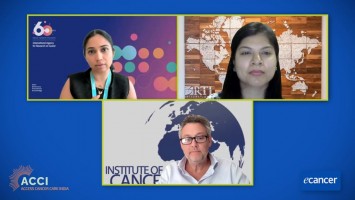I was part of the surgical course today and I was addressing the topic about neoadjuvant chemotherapy and the Karolinska experience. That talk was based on the fact that neoadjuvant chemotherapy is increasing and we have a national breast cancer quality register so we are able to catch all patients being operated on. I presented the results from the register studies made by two medical students supervised by colleagues of mine in oncology and in breast surgery.
Looking at both the rate, firstly, of reoperations after breast conservation as a final procedure and finding out that this is quite low, 8% of cases actually had to do a second operation. We also presented data on the evolution of treatment for breast cancer that was in the ‘70s mostly surgical, mostly mastectomy, then with the introduction of breast conservation we saw a change in the occurrence rate, quite late actually, in 1995, to see that breast conserving therapy was becoming more prevalent than mastectomy. We also have seen a dramatic change in the use of adjuvant therapy like chemotherapy that was given to quite a low proportion of women or patients at that time and now is given to about 40% of cases in Sweden will receive chemotherapy.
Endocrine therapy is, of course, to all cases where we have receptor positivity so that level is quite high because half of our cases are stage 1, small tumours, and we can also see that 85%, roundabout, will actually keep their breast. So we have quite a specific panorama of early breast cancer in Sweden.
We then looked at a series of around a thousand cases having had neoadjuvant chemotherapy with the goal to see how many of these patients could actually preserve the breast because that’s one of the goals of neoadjuvant chemotherapy. We also looked at time trends and if there was anything in tumour biology that would predict the possibility of preserving the breast. What we found was, of course, that in the later time trends there was more breast conservation being done. So looking at 2015-17 40% of the cases actually had breast conservation as their final procedure. We saw that it’s more directed towards tumour biology, smaller tumours, offering this kind of treatment and we also saw that the HER2 positive cases, triple negative cases were more likely to receive breast conservation.
We also had the possibility to briefly look at local recurrence because we do know that survival figures between neoadjuvant and adjuvant are almost non-existing but quality of life is also a very important issue. We found that there was a very, very small difference, however, in favour to breast conservation after neoadjuvant chemotherapy.
We can also debate what are the factors to more deem the success of the procedure and maybe the radiological appearance is quite important to see that you have a complete response and when you operate that you do not find any viable tumour neither in the breast or in the axilla.
What can we expect to see in the next 5 years?
I think we’ve already seen the tremendous increase in neoadjuvant chemotherapy because the aim is to convert locally advanced breast cancer into treatable breast cancer to be able to monitor the effect and to be able to change regimen if you don’t get a response. So that’s where we’re going and the conventional setting of having chemotherapy at the end was that surgery was the dominating procedure but now when we are more directed and we have more information about tumour biology already from the start from our core needle biopsies we can be more tailored to what kind of treatment we are actually going to recommend to the patient. We are also being in the possibility of monitoring that with patients’ outcome, looking at baseline data and also following through because, as I said, survival figures are likely not to be very different but local recurrence is also something extremely handicapping for any patient who suffers from that and has also, of course, an impact on survival at the end.








